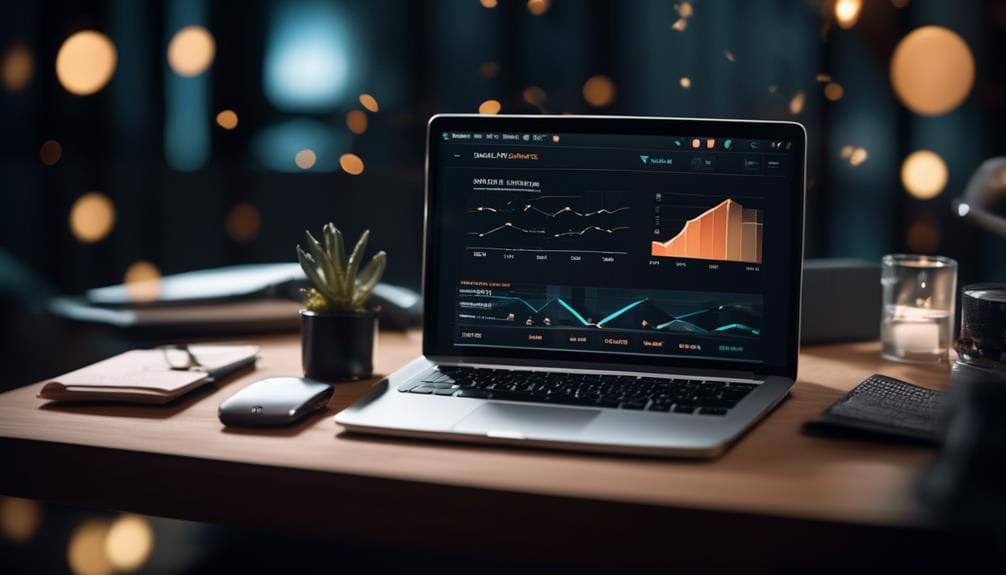Last Chance to Stay Ahead: Essential Automation Tools for Email Marketers
In today's digital age, where communication is faster than ever before, staying ahead as an email marketer can feel like a daunting task. With countless messages flooding inboxes every day, how can you ensure that your emails stand out from the crowd and capture your audience's attention?
The answer lies in the power of automation. By utilizing essential automation tools, you can streamline your email marketing efforts and maximize your results. But which tools are truly essential? Which ones will give you that last chance to stay ahead?
Well, buckle up and get ready, because in this discussion, we will uncover the key automation tools that every email marketer should have in their arsenal.
Key Takeaways
- Email scheduling and optimization tools can enhance email marketing strategies by sending targeted emails at optimal times, increasing engagement and avoiding peak traffic periods.
- List segmentation and personalization tools maximize the effectiveness of email marketing campaigns by targeting specific groups based on interests, demographics, or behavior, tailoring messages for better resonance and improving user experience.
- Dynamic content customization tools enhance the effectiveness of email marketing campaigns by delivering personalized messages to individual recipients, connecting with the audience on a deeper level, and increasing engagement and conversions.
- Autoresponders and optimization tools enhance email marketing efforts by providing automated and timely responses, saving time and effort, delivering personalized experiences, and nurturing leads to build relationships and increase engagement and conversions.
Email Scheduling

You can enhance your email marketing strategy by utilizing email scheduling, a powerful automation tool that allows you to send targeted emails at the optimal time for maximum impact. With email scheduling, you can ensure that your emails are delivered when your audience is most likely to be engaged and ready to take action. By analyzing email performance data, you can identify the best times to send emails based on open rates, click-through rates, and conversion rates.
Email delivery optimization is a key benefit of email scheduling. By scheduling your emails to be sent at specific times, you can avoid sending them during peak email traffic periods, where they may get lost or overlooked. Instead, you can send your emails when your audience's inboxes are less crowded, increasing the chances of them being seen and opened.
Furthermore, email performance analysis is another advantage of using email scheduling. By analyzing the data from your email campaigns, you can gain insights into what works and what doesn't. You can track metrics such as open rates, click-through rates, and conversions to determine the effectiveness of your emails. This analysis allows you to make data-driven decisions and optimize your email marketing strategy for better results.
List Segmentation
To maximize the effectiveness of your email marketing campaigns, consider implementing list segmentation, a strategic technique that allows you to target specific groups of subscribers based on their interests, demographics, or past behavior. By dividing your email list into smaller segments, you can tailor your messages to better resonate with each group, ultimately increasing email deliverability and open rate optimization.
List segmentation allows you to send more relevant and personalized content to your subscribers, resulting in higher engagement and conversion rates. Instead of sending a generic email to your entire list, you can craft targeted messages that address the specific needs and preferences of each segment. This not only improves the user experience but also increases the chances of your emails being opened and clicked on.
Consider the following table showcasing different ways you can segment your email list:
| Segment | Criteria |
|---|---|
| Past Customers | Purchase history |
| Location | Geographic location |
| Interests | Product preferences |
Segmenting your list based on these criteria allows you to send tailored promotions to past customers, location-specific offers to subscribers in different regions, and content related to their specific interests. This level of personalization leads to higher engagement and ultimately improves your email deliverability and open rates.
Incorporating list segmentation into your email marketing strategy is a powerful tool that can significantly enhance the effectiveness of your campaigns. By targeting specific groups of subscribers with personalized content, you can increase engagement, improve deliverability, and optimize your open rates. Start implementing list segmentation today and watch your email marketing efforts thrive.
Personalization Tags

Are you looking to take your email marketing to the next level?
Personalization tags are the key to creating dynamic and customized content that speaks directly to your audience.
By using automated email personalization, you can tailor your messages to each individual subscriber, increasing engagement and conversions.
With targeted audience segmentation, you can ensure that your emails are delivered to the right people at the right time, maximizing the impact of your campaigns.
Dynamic Content Customization
By utilizing dynamic content customization, you can enhance the effectiveness of your email marketing campaigns by delivering personalized messages tailored to each individual recipient. This level of personalization allows you to connect with your audience on a deeper level, increasing engagement and driving conversions.
Here is a visual representation of the benefits of dynamic content customization:
| Benefits of Dynamic Content Customization | ||
|---|---|---|
| 1. Real-time personalization | 2. Behavioral triggers | 3. Increased engagement |
| 4. Higher conversion rates | 5. Improved customer satisfaction | 6. Enhanced brand loyalty |
Real-time personalization ensures that your emails are relevant and timely, capturing the attention of your recipients. By using behavioral triggers, you can send targeted emails based on your customers' actions, further increasing the likelihood of conversions. This level of customization not only improves engagement, but also boosts customer satisfaction and promotes brand loyalty. Don't miss out on the opportunity to stay ahead in the competitive world of email marketing.
Automated Email Personalization
Automate your email personalization using personalization tags to deliver tailored messages that resonate with your recipients. Personalization tags allow you to dynamically insert unique information into your emails, such as the recipient's name, location, or previous purchase history.
By utilizing these email customization techniques, you can create a personalized email strategy that speaks directly to the individual needs and preferences of your audience. This level of personalization not only increases engagement and click-through rates but also strengthens the relationship between your brand and the recipient.
With automated email personalization, you can efficiently send targeted emails at scale, saving you time and effort. So, don't miss out on this opportunity to connect with your audience on a deeper level and stay ahead of the competition. Start incorporating personalization tags into your email marketing campaigns today.
Targeted Audience Segmentation
To further enhance your email personalization strategy, take advantage of targeted audience segmentation through the use of personalization tags.
Behavioral targeting and geographic segmentation are two powerful techniques that can help you serve your audience better. By analyzing your subscribers' behavior and interests, you can tailor your email content to their specific needs and preferences.
Personalization tags allow you to insert dynamic content into your emails, such as the recipient's name or location, creating a more personalized and engaging experience. With behavioral targeting, you can send relevant offers based on past purchases or browsing history, increasing the chances of conversion.
Geographic segmentation enables you to deliver location-specific content or promotions, making your emails more relevant and impactful.
Autoresponders

You can enhance your email marketing efforts by incorporating the use of autoresponders, which allow for automated and timely responses to your subscribers. Autoresponders not only save you time and effort but also help you provide a personalized experience to your audience. With autoresponder customization, you can tailor your messages to match the interests and preferences of your subscribers, ensuring that you deliver relevant content that resonates with them.
One of the key benefits of using autoresponders is their ability to improve your email marketing performance. By automating the process of sending follow-up messages, you can nurture your leads and build stronger relationships with your subscribers. This consistent and timely communication helps keep your brand top of mind while increasing engagement and conversions.
In addition to sending automated responses, autoresponders also allow you to segment your audience based on their interactions with your emails. By analyzing the data, you can identify the most engaged subscribers and tailor your future campaigns to their specific needs and interests. This targeted approach ensures that you're delivering the right message to the right people at the right time, maximizing the effectiveness of your email marketing campaigns.
A/B Testing
Enhance your email marketing performance by utilizing the power of A/B testing to optimize your campaigns and maximize your results. A/B testing, also known as split testing, allows you to compare two versions of an email to determine which one performs better in terms of conversion rate, click-through rate, and other key metrics. By conducting A/B tests, you can gain valuable insights into what resonates with your audience and make data-driven decisions to improve your email marketing strategy.
Here is a table that highlights the importance of A/B testing in conversion optimization and performance analysis:
| A/B Testing Benefits | Conversion Optimization | Performance Analysis |
|---|---|---|
| Test different subject lines to identify the most compelling one | Increase email open rates and engagement | Understand what messaging resonates with your audience |
| Experiment with different email layouts and designs | Improve click-through rates and conversion rates | Determine the most effective design elements |
| Test different calls to action to determine the most effective one | Drive more conversions and revenue | Identify the best approach to encourage action |
Analytics and Reporting

Utilize powerful analytics and reporting tools to gain actionable insights into the performance of your email marketing campaigns. Data analysis and performance tracking are crucial in understanding how well your campaigns are performing and identifying areas for improvement. With the right tools, you can gather valuable data on open rates, click-through rates, conversions, and more.
Analytics tools provide you with in-depth information about your audience, allowing you to segment and target your campaigns more effectively. By analyzing the data, you can identify trends, preferences, and behaviors of your subscribers, enabling you to tailor your content and offers accordingly. This level of personalization can significantly improve engagement and conversion rates.
Reporting tools offer comprehensive and easy-to-understand visualizations of your email marketing performance. They provide you with key metrics and KPIs, such as delivery rates, bounce rates, and unsubscribe rates, allowing you to monitor the success of your campaigns in real-time. By regularly reviewing these reports, you can quickly identify any issues and make informed decisions to optimize your future campaigns.
Frequently Asked Questions
How Do I Determine the Best Time to Schedule My Emails for Maximum Engagement?
To determine the best time to schedule your emails for maximum engagement, utilize email scheduling strategies and conduct A/B testing. By analyzing the results, you can optimize your email marketing efforts and ensure your messages reach your audience at the right time.
Can I Segment My Email List Based on Specific Customer Behaviors or Preferences?
Yes, you can segment your email list based on specific customer behaviors or preferences. This allows for targeted email personalization and ensures that your messages resonate with each individual, increasing engagement and driving better results.
What Are Some Examples of Personalization Tags and How Can I Use Them to Enhance My Email Campaigns?
Using personalization tags in your email campaigns is a powerful way to connect with your audience. By tailoring your messages based on their preferences and behaviors, you can enhance engagement and build stronger relationships.
How Can Autoresponders Help Me Save Time and Improve My Email Marketing Efforts?
Autoresponders can save you time and enhance your email marketing efforts. By automating tasks like welcome emails and follow-ups, you can focus on other important aspects of your business while still providing a personalized experience for your subscribers.
What Are the Key Metrics I Should Be Analyzing in My Email Marketing Campaigns and How Can I Effectively Use the Data for Future Improvements?
To effectively improve your email marketing campaigns, analyze key metrics such as open rates, click-through rates, and conversion rates. Use this data to make data-driven improvements, optimizing your emails for better engagement and results.
Conclusion
In conclusion, to stay ahead as an email marketer, it's essential to utilize automation tools.
By scheduling emails, segmenting lists, using personalization tags, setting up autoresponders, and conducting A/B testing, you can optimize your email campaigns and improve their effectiveness.
Additionally, utilizing analytics and reporting tools will provide valuable insights to make data-driven decisions.
Don't miss out on the opportunity to streamline your email marketing efforts and achieve better results.
Start leveraging these essential automation tools today.








